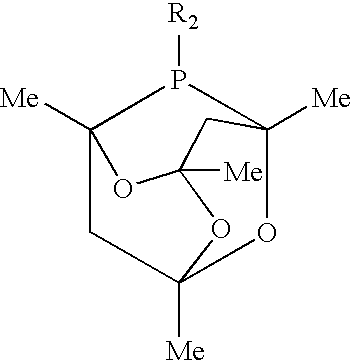Process of preparing ethylene glycol
a technology of ethylene glycol and ethylene glycol, which is applied in the field of preparing glycolaldehyde and a process of preparing ethylene glycol, can solve the problems of lowering the yield of glycolaldehyde, lessening the effectiveness of glycolaldehyde, and giving less conversion and selectivity to glycolaldehyd
- Summary
- Abstract
- Description
- Claims
- Application Information
AI Technical Summary
Problems solved by technology
Method used
Image
Examples
example 1
(“2-PA”-C20 Ligand in Non-Aqueous Conditions)
[0048]The autoclave was charged with 0.17 mol of formaldehyde, in the form of para-formaldehyde, 62 ml (0.58 mol) of N-methyl-pyrrolidone, 0.25 mmol of rhodiumdicarbonylacetonylacetone (Rh(acac)(CO)2), 0.50 mmol of 2-phospha-2-icosyl-1,3,5,7-tetramethyl-6,9,10-trioxa-tricyclo[3.3.1.1{3,7}]-decane, and 9.1 mmol of trimethylbenzoic acid. The contents of the autoclave were then heated to a temperature of 110° C. and maintained at that temperature for 2 hours.
[0049]Conversion of formaldehyde was 100% and the yield of glycolaldehyde, calculated on formaldehyde intake, was 76%. The initial reaction rate was calculated by measurement of the pressure drop to be 595 mol CO / mol Rh.h.
example 2
(“2-PA”—C20 Ligand in Aqueous Conditions)
[0050]The autoclave was charged with 0.17 mol of formaldehyde, in the form of para-formaldehyde, 35 ml (0.22 mol) of dibutyl-acetamide, 25 ml of demineralised water, 0.25 mmol of Rh(acac) (CO)2, 0.53 mmol of 2-phospha-2-icosyl-1,3,5,7-tetramethyl-6,9,10-trioxa -tricyclo[3.3.1.1{3,7}]-decane, and 9.1 mmol of trimethylbenzoic acid. The contents of the autoclave were heated to a temperature of 110° C. and maintained at that temperature for 5 hours.
[0051]Conversion of formaldehyde was 64% and the yield of glycolaldehyde in the two-phase reaction product, calculated on formaldehyde intake, was 45%. The initial reaction rate was calculated by measurement of the pressure drop to be 115 mol CO / mol Rh.h
example 3
(“2-PA”—CH2CH2C(O)NMe2 Ligand in Non-Aqueous Conditions)
[0052]The autoclave was charged with 0.18 mol of formaldehyde, in the form of para-formaldehyde, 23 ml (0.15 mol) of di-sec-butyl-acetamide, 0.25 mmol of Rh(acac)(CO)2, 0.49 mmol of 2-phospha-2-(ethyl-N,N-dimethylamido) -1,3,5,7-tetramethyl-6,9,10-trioxa -tricyclo[3.3.1.1{3,7}]-decane, and 9.1 mmol of trimethylbenzoic acid. The contents of the autoclave were then heated to a temperature of 100° C. and maintained at that temperature for 3 hours.
[0053]Conversion of formaldehyde was 72% and the yield of glycolaldehyde in the single-phase reaction product, calculated on formaldehyde intake, was 69%. The initial reaction rate was calculated by measurement of the pressure drop to be 275 mol CO / mol Rh.h.
PUM
| Property | Measurement | Unit |
|---|---|---|
| pressure | aaaaa | aaaaa |
| pressure | aaaaa | aaaaa |
| pressure | aaaaa | aaaaa |
Abstract
Description
Claims
Application Information
 Login to View More
Login to View More - R&D
- Intellectual Property
- Life Sciences
- Materials
- Tech Scout
- Unparalleled Data Quality
- Higher Quality Content
- 60% Fewer Hallucinations
Browse by: Latest US Patents, China's latest patents, Technical Efficacy Thesaurus, Application Domain, Technology Topic, Popular Technical Reports.
© 2025 PatSnap. All rights reserved.Legal|Privacy policy|Modern Slavery Act Transparency Statement|Sitemap|About US| Contact US: help@patsnap.com

